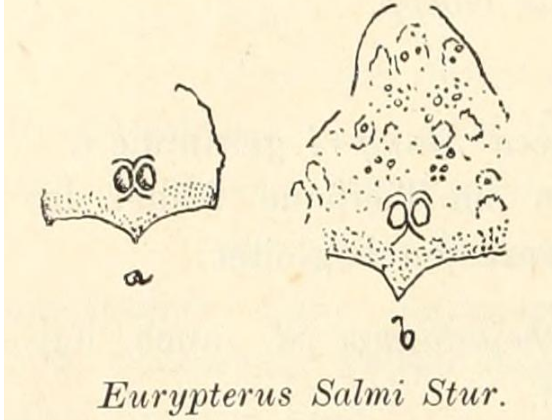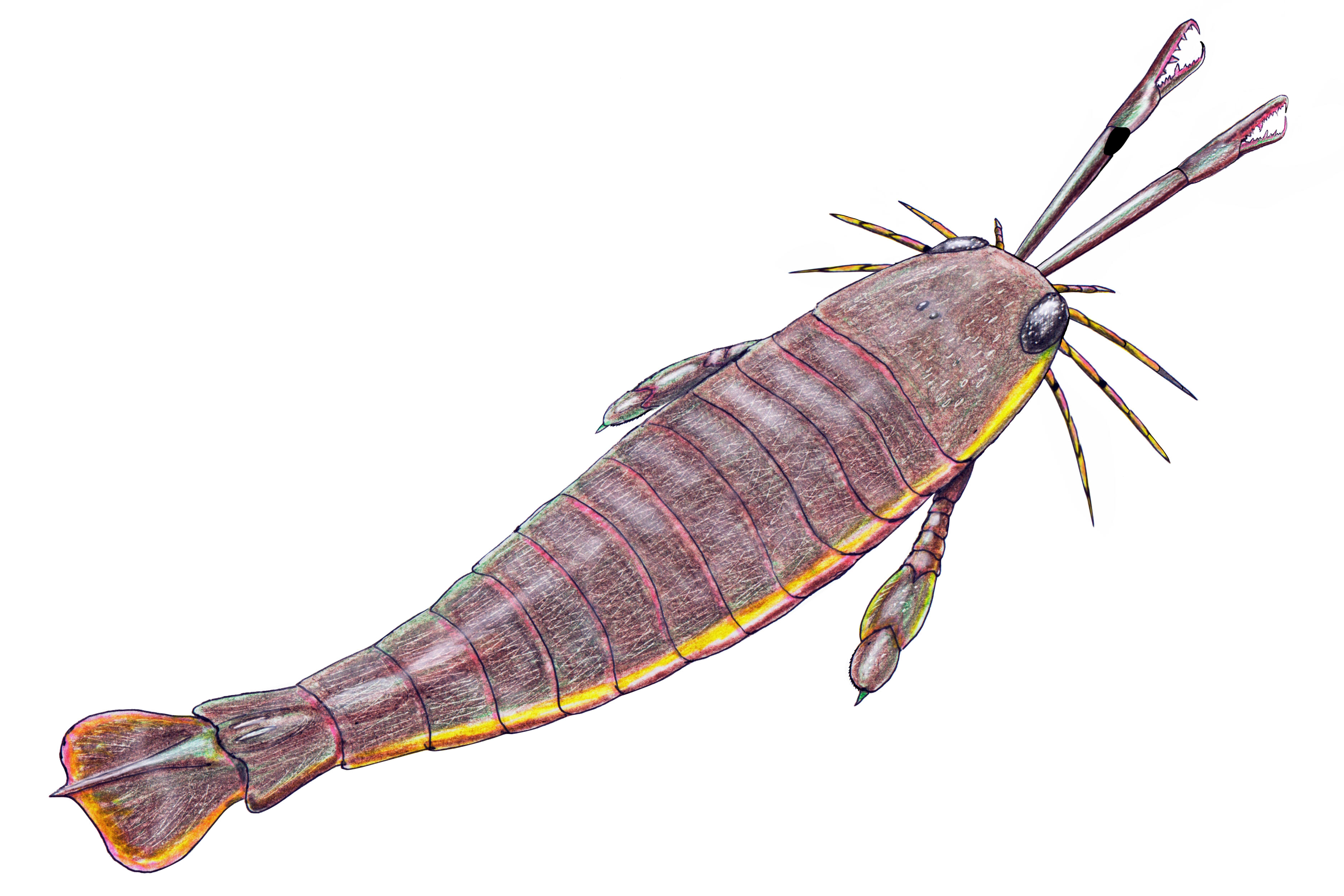|
Hibbertopterid
Hibbertopteridae (the name deriving from the type genus ''Hibbertopterus'', meaning "Samuel Hibbert-Ware, Hibbert's wing") is a family of Eurypterid, eurypterids, an extinct group of aquatic Arthropod, arthropods. They were members of the superfamily Mycteropoidea. Hibbertopterids were large, broad and heavy animals unlike virtually every other group of eurypterids, which are commonly streamlined and lightweight. Their bizarre morphology is so unusual that they in the past have been thought to represent an entirely distinct order of Chelicerata, chelicerates. Fossils of the family first appear in deposits of Middle Devonian age and the last known fossils representing hibbertopterids are known from deposits of Late Permian age. The hibbertopterids represent the last known living eurypterids, going extinct during the Permian–Triassic extinction event or shortly before. Although eurypterids are commonly known as "sea scorpions", hibbertopterids inhabited freshwater swamps and rivers ... [...More Info...] [...Related Items...] OR: [Wikipedia] [Google] [Baidu] |
Mycteropoidea
Mycteropoidea is an extinct superfamily of eurypterids, an extinct group of chelicerate arthropods commonly known as "sea scorpions". It is one of four superfamilies classified as part of the suborder Stylonurina. Mycteropoids have been recovered from Europe, Russia, South America and South Africa. Mycteropoid specimens are often fragmentary, making it difficult to establish relationships between the included taxa. Only two mycteropoid taxa are known from reasonable complete remains, '' Hibbertopterus scouleri'' and ''H. wittebergensis''. Mycteropoids were large bizarre Eurypterids found from the Early Silurian to the end of the Permian period. They were sweep feeders, inhabiting freshwater swamps and rivers, feeding by raking through the soft sediment with blades on their anterior appendages to capture small invertebrates. Their morphology was so unusual that they have been thought to be an order separate to Eurypterida. Recent work however confirms them to be derived members o ... [...More Info...] [...Related Items...] OR: [Wikipedia] [Google] [Baidu] |
Vernonopterus
''Vernonopterus'' is a genus of eurypterid, a group of extinct aquatic arthropods. Fossils of ''Vernonopterus'' have been discovered in deposits of the Carboniferous period in Scotland. The name of the genus derives from the location where the only known fossil has been discovered, Mount Vernon near Airdrie in Lanarkshire, Scotland. A single species of ''Vernonopterus'' is recognized, ''V. minutisculptus'', based on fragmentary fossilized tergites, segments on the upper side of the abdomen. The species name ''minutisculptus'' refers to the ornamentation of scales that covers the entirety of the preserved parts of the eurypterid. Although little can confidently be said about the appearance of ''Vernonopterus'', it is likely to have been similar to its relatives within the hibbertopterid family, ''Hibbertopterus'' and '' Campylocephalus''. The hibbertopterids were large eurypterids with broad heads and bodies and appendages developed for sweep-feeding, a technique involving blade- ... [...More Info...] [...Related Items...] OR: [Wikipedia] [Google] [Baidu] |
Hibbertopterus
''Hibbertopterus'' is a genus of eurypterid, a group of extinct aquatic arthropods. Fossils of ''Hibbertopterus'' have been discovered in deposits ranging from the Devonian period in Belgium, Scotland and the United States to the Carboniferous period in Scotland, Ireland, the Czech Republic and South Africa. The type species, ''H. scouleri'', was first named as a species of the significantly different ''Eurypterus'' by Samuel Hibbert in 1836. The generic name ''Hibbertopterus'', coined more than a century later, combines his name and the Greek word πτερόν (''pteron'') meaning "wing". ''Hibbertopterus'' was the largest eurypterid within the stylonurine suborder, with the largest fossil specimens suggesting that ''H. scouleri'' could reach lengths around 180–200 centimetres (5.9–6.6 ft). Though this is significantly smaller than the largest eurypterid overall, ''Jaekelopterus'', which could reach lengths of around , ''Hibbertopterus'' is likely to have been the h ... [...More Info...] [...Related Items...] OR: [Wikipedia] [Google] [Baidu] |
Campylocephalus
''Campylocephalus'' is a genus of eurypterid, a group of extinct aquatic arthropods. Fossils of ''Campylocephalus'' have been discovered in deposits ranging from the Carboniferous period in the Czech Republic (the species ''C. salmi'') to the Permian period of Russia (species ''C. oculatus'' and ''C. permianus''). The generic name is composed of the Greek words καμπύλος (''kampýlos''), meaning "curved", and κεφαλή (''kephalē''), meaning "head". It was a member of the hibbertopterid family of eurypterids and probably looked much the same as the other members of the family, ''Hibbertopterus'' and '' Vernonopterus'', in that it was a large, broad and heavy animal quite different from the famous swimming eurypterids (such as ''Pterygotus'' and ''Eurypterus'') which had been common during earlier periods. Like all other stylonurine eurypterids, ''Campylocephalus'' completely lacked swimming paddles. Hibbertopterids such as ''Campylocephalus'' were, as many other fa ... [...More Info...] [...Related Items...] OR: [Wikipedia] [Google] [Baidu] |
Hibbertopterus Scouleri
''Hibbertopterus'' is a genus of eurypterid, a group of extinct aquatic arthropods. Fossils of ''Hibbertopterus'' have been discovered in deposits ranging from the Devonian period in Belgium, Scotland and the United States to the Carboniferous period in Scotland, Ireland, the Czech Republic and South Africa. The type species, ''H. scouleri'', was first named as a species of the significantly different ''Eurypterus'' by Samuel Hibbert in 1836. The generic name ''Hibbertopterus'', coined more than a century later, combines his name and the Greek word πτερόν (''pteron'') meaning "wing". ''Hibbertopterus'' was the largest eurypterid within the stylonurine suborder, with the largest fossil specimens suggesting that ''H. scouleri'' could reach lengths around 180–200 centimetres (5.9–6.6 ft). Though this is significantly smaller than the largest eurypterid overall, ''Jaekelopterus'', which could reach lengths of around , ''Hibbertopterus'' is likely to have been the h ... [...More Info...] [...Related Items...] OR: [Wikipedia] [Google] [Baidu] |
Eurypterid
Eurypterids, often informally called sea scorpions, are a group of extinct arthropods that form the Order (biology), order Eurypterida. The earliest known eurypterids date to the Darriwilian stage of the Ordovician period 467.3 Myr, million years ago. The group is likely to have appeared first either during the Early Ordovician or Late Cambrian period. With approximately 250 species, the Eurypterida is the most diverse Paleozoic Chelicerata, chelicerate order. Following their appearance during the Ordovician, eurypterids became major components of marine faunas during the Silurian, from which the majority of eurypterid species have been described. The Silurian genus ''Eurypterus'' accounts for more than 90% of all known eurypterid specimens. Though the group continued to diversify during the subsequent Devonian period, the eurypterids were heavily affected by the Late Devonian extinction event. They declined in numbers and diversity until becoming extinct during the Permian–Tri ... [...More Info...] [...Related Items...] OR: [Wikipedia] [Google] [Baidu] |
Stylonurina
Stylonurina is one of two suborders of eurypterids, a group of extinct arthropods commonly known as "sea scorpions". Members of the suborder are collectively and informally known as "stylonurine eurypterids" or "stylonurines". They are known from deposits primarily in Europe and North America, but also in Siberia. Compared to the other suborder, Eurypterina, the stylonurines were comparatively rare and retained their posterior prosomal appendages for walking. Despite their rarity, the stylonurines have the longest temporal range of the two suborders. The suborder contains some of the oldest known eurypterids, such as ''Brachyopterus'', from the Middle Ordovician as well as the youngest known eurypterids, from the Late Permian. They remained rare throughout the Ordovician and Silurian, though the radiation of the mycteropoids (a group of large sweep-feeding forms) in the Late Devonian and Carboniferous is the last major radiation of the eurypterids before their extinction in the Pe ... [...More Info...] [...Related Items...] OR: [Wikipedia] [Google] [Baidu] |
Jaekelopterus
''Jaekelopterus'' is a genus of predatory eurypterid, a group of extinct aquatic arthropods. Fossils of ''Jaekelopterus'' have been discovered in deposits of Early Devonian age, from the Pragian and Emsian stages. There are two known species: the type species ''J. rhenaniae'' from brackish to fresh water strata in the Rhineland, and ''J. howelli'' from estuarine strata in Wyoming. The generic name combines the name of German paleontologist Otto Jaekel, who described the type species, and the Greek word πτερόν (''pteron'') meaning "wing". Based on the isolated fossil remains of a large chelicera (claw) from the Klerf Formation of Germany, ''J. rhenaniae'' has been estimated to have reached a size of around 2.3–2.6 metres (7.5–8.5 ft), making it the largest arthropod ever discovered, surpassing other large arthropods such as fellow eurypterids '' Acutiramus'' and ''Pterygotus'' and the millipede ''Arthropleura''. ''J. howelli'' was much smaller, reaching 80 ce ... [...More Info...] [...Related Items...] OR: [Wikipedia] [Google] [Baidu] |
Pterygotidae
Pterygotidae (the name deriving from the type genus ''Pterygotus'', meaning "winged one") is a family of eurypterids, an extinct group of aquatic arthropods. They were members of the superfamily Pterygotioidea. Pterygotids were the largest known arthropods to have ever lived with some members of the family, such as ''Jaekelopterus'' and '' Acutiramus'', exceeding 2 metres (6.6 ft) in length. Their fossilized remains have been recovered in deposits ranging in age from 428 to 372 million years old ( Late Silurian to Late Devonian). One of the most successful groups of eurypterids, the pterygotids were the only eurypterid family to achieve a truly worldwide distribution. Several evolutionary innovations made the pterygotids unique among the eurypterids, with large and flattened telsons (the posteriormost division of the body) likely used as rudders to provide additional agility and enlarged chelicerae (frontal appendages) with claws. These claws were robust and possessed tee ... [...More Info...] [...Related Items...] OR: [Wikipedia] [Google] [Baidu] |
Digital Object Identifier
A digital object identifier (DOI) is a persistent identifier or handle used to uniquely identify various objects, standardized by the International Organization for Standardization (ISO). DOIs are an implementation of the Handle System; they also fit within the URI system ( Uniform Resource Identifier). They are widely used to identify academic, professional, and government information, such as journal articles, research reports, data sets, and official publications. DOIs have also been used to identify other types of information resources, such as commercial videos. A DOI aims to resolve to its target, the information object to which the DOI refers. This is achieved by binding the DOI to metadata about the object, such as a URL where the object is located. Thus, by being actionable and interoperable, a DOI differs from ISBNs or ISRCs which are identifiers only. The DOI system uses the indecs Content Model for representing metadata. The DOI for a document remains fixed over t ... [...More Info...] [...Related Items...] OR: [Wikipedia] [Google] [Baidu] |
Biology Letters
''Biology Letters'' is a peer-reviewed, biological, scientific journal published by the Royal Society. It focuses on the rapid publication of short high quality research articles, reviews and opinion pieces across the biological sciences. ''Biology Letters'' has an average turnaround time of twenty four days from submission to a first decision. The editor-in-chief is Professor David Beerling FRS (University of Sheffield) who is supported by an international Editorial Board of practising scientists. Contents and themes As well as the conventional, short research articles, ''Biology Letters'' has recently published Special Features and Mini Series. While Special Features are a collection of up to 20 articles on a specific theme and published across multiple issues, Mini Series include up to six articles that are published in one issue. Examples of topics in these formats include ocean acidification, fossils, extinction, enhanced rock weathering and the evolutionary ecology of sp ... [...More Info...] [...Related Items...] OR: [Wikipedia] [Google] [Baidu] |







_(5977251311).jpg)